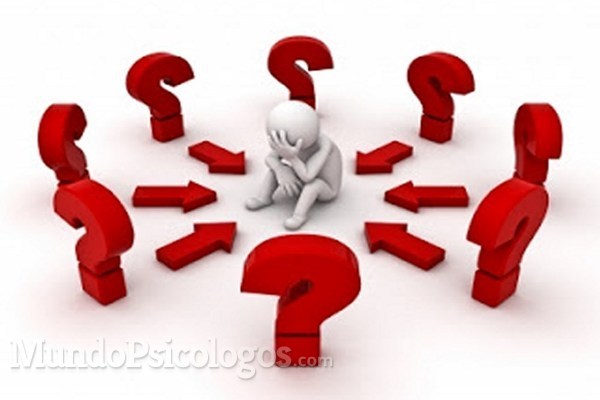Don’t know what mental illness really is? What is the difference between mental disorder and mental illness? Discover the most common mental problems today.
Often, people feel that something is not right, that too much time has passed, that we have not found our way, and that nothing will change the situation. We must understand that we are usually exposed to life’s problems, to a greater or lesser extent, and that on many occasions we do not have the necessary resources to solve them. Therefore, we must try to identify the mental diseases What we can suffer to achieve balance in our lives.
Normally, the mental illness and mental disorder They are used interchangeably during our daily lives. Despite this, for many people there is a difference between mental illnesses and mental disorders.
What are mental illnesses?
A Mental illness It is a pathological condition resulting from a disease of the body or mind. These abnormal conditions are usually caused by infection, inflammation, environmental factors, or a genetic defect. Therefore, a mentally ill person can be detected through a group of symptoms or signs.
What are mental disorders?
In ancient times, the mental disorders They were seen as an affectation that came from having problems with the mind. On the other hand, today we know that a mental disorder can affect the brain and the functioning of the individual. Currently, the medical definition of a mental disorder is that it is a disturbance in the normal physical or mental health of the mind or body. For example, a person with an eating disorder or a personality disorder may be called having a mental disorder.
Difference between disorder and mental illness
Before there was more knowledge about mental health, experts believed that the term ‘disorders’ was a much better fit than ‘diseases’ to denote problems that came from the mind or brain. Now, scientists show that mental illnesses are an affectation of the body. Therefore, the main difference between mental disorder and mental illness It is the origin of the affectation.
Despite this, the term of mental disorder It is broader than a mental illness and applies to any mental health disorder, whether or not it is a consequence of a known somatic disorder. Today, most mental health professionals do not make a distinction between these two concepts.

What types of mental illnesses exist?
According to the DSM-5, that is, the Diagnostic and Statistical Manual of mental disorders , there are almost 300 mental illnesses today. Among the most widespread currently we find the following.
1. Anxiety disorders
One of the mental problems The most widespread today are anxiety disorders. These are characterized by fear, worry, recurrent panicked thoughts about the future, and even related behavioral alterations. In this way, these mental disorders end up making people feel fear that involves an emotional response to a threat, whether real or perceived. This happens since anxiety implies an anticipation that may arise in the future. The most widespread anxiety disorders are the following.
- Generalized anxiety disorder (GAD)
- Agoraphobia
- Social anxiety disorder
- Specific phobias
- panic disorder
- Separation anxiety disorder
2. Eating disorders
The mental disorders Related to eating are characterized by obsessive concerns with weight and eating patterns that affect both physically and mentally. Among the best known are:
- anorexia nervosa
- Bulimia nervosa
- Rumination disorder
- Binge eating disorder
3. Mood disorders
Another of the types of mental illness Depressive disorders are more widespread. In them, the mentally ill experiences a sad, empty or irritated state of mind. Furthermore, this psychological illness is usually accompanied by physical and cognitive symptoms. Among the most widespread there are the following.
- Disruptive mood dysregulation disorder
- Major depressive disorder
- Persistent depressive disorder (dysthymia)
- Other depressive disorder or unspecified depressive disorder
- Premenstrual dysphoric disorder
- Substance/medication-induced depressive disorder
- Depressive disorder due to another medical condition
4. Personality disorders
The personality disorders They are diseases of the mind that are characterized by a long-lasting pattern of thinking that affects feelings, emotions and maladaptive behaviors that can cause serious damage to relationships and other areas of life.
- Antisocial personality disorder
- Avoidant personality disorder
- Borderline personality disorder
- Dependent personality disorder
- Histrionic personality disorder
- Narcissistic personality disorder
- Obsessive-compulsive personality disorder
- Paranoid personality disorder
- Schizoid personality Disorder
- Schizotypal personality disorder
5. Sleep disorders
One of the mental problems that are most widespread today are sleep disorders. These mental illnesses disrupt sleep patterns and cause distress, as well as affect daytime functioning. Some of the examples are:
- Narcolepsy
- Insomnia disorder
- Hypersomnolence
- Parasomnias
6. Substance abuse disorders
This psychological illness It is related to people who use substances and abuse them to obtain immediate pleasure that ends up leading to mental and physical problems. Some individuals who suffer from it may suffer intoxication, withdrawal, the appearance of psychosis, anxiety and even delirium.
7. Stress-related disorders
The mental diseases Related stressors involve exposure to an event that is stressful or traumatic. Previously, medical diagnosis combined it with anxiety disorders, but currently they are included in a different category. Among the most widespread there are:
- Acute stress disorder
- Adjustment disorders
- Post-traumatic stress disorder
- Reactive attachment disorder
If you think you may suffer from one of these mental diseases , go to a professional psychologist. Despite this, you should know that everyone has days when they feel physically ill, but that does not mean that their general health is in decline or that they have a serious illness. The same can be said for your mental health. You may experience days where you feel stressed or sad, but that doesn’t mean you have a mental illness.











